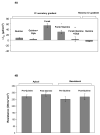Bioelectric effects of quinine on polarized airway epithelial cells
- PMID: 17329172
- PMCID: PMC2077327
- DOI: 10.1016/j.jcf.2007.01.001
Bioelectric effects of quinine on polarized airway epithelial cells
Abstract
Quinine has been increasingly utilized as a placebo in cystic fibrosis (CF) clinical trials, including those leading to FDA approval of inhaled tobramycin, recent studies of anti-inflammatory aerosols such as glutathione, and clinical testing of hypertonic saline aerosols to augment mucous clearance. The drug effectively masks taste of experimental therapeutics, but could also confer changes in processes contributing to CF pathogenesis, including chloride secretion and paracellular ion permeability. In the Ussing chamber, concentrations of quinine (1 mg/ml) anticipated in the airways of CF subjects after aerosolization led to changes in chloride transport in Calu-3 (airway serous glandular) cell monolayers. Tissue resistance was significantly disrupted by the compound in both Calu-3 and primary airway epithelial cells in vitro. Lower doses of quinine (between 10 and 100 microg/ml) strongly inhibited the chloride secretory mechanism that utilizes CFTR, and forskolin activated I(SC) was reduced by approximately 24% and 44% in the presence of 10 and 100 microg/ml quinine, respectively. Our findings indicate that quinine disrupts airway epithelial functional integrity and blocks transepithelial chloride transport. The use of quinine as a taste-masking agent may have bioelectric effects relevant to CF trials using aerosolized drug delivery.
Figures






Similar articles
-
Chloride transporting capability of Calu-3 epithelia following persistent knockdown of the cystic fibrosis transmembrane conductance regulator, CFTR.Br J Pharmacol. 2007 Apr;150(8):1055-65. doi: 10.1038/sj.bjp.0707175. Epub 2007 Mar 5. Br J Pharmacol. 2007. PMID: 17339840 Free PMC article.
-
CFTR delivery to 25% of surface epithelial cells restores normal rates of mucus transport to human cystic fibrosis airway epithelium.PLoS Biol. 2009 Jul;7(7):e1000155. doi: 10.1371/journal.pbio.1000155. Epub 2009 Jul 21. PLoS Biol. 2009. PMID: 19621064 Free PMC article.
-
Bile acids stimulate chloride secretion through CFTR and calcium-activated Cl- channels in Calu-3 airway epithelial cells.Am J Physiol Lung Cell Mol Physiol. 2014 Sep 1;307(5):L407-18. doi: 10.1152/ajplung.00352.2013. Epub 2014 Jul 3. Am J Physiol Lung Cell Mol Physiol. 2014. PMID: 24993131
-
Pharmacotherapy of the ion transport defect in cystic fibrosis: role of purinergic receptor agonists and other potential therapeutics.Am J Respir Med. 2003;2(4):299-309. doi: 10.1007/BF03256658. Am J Respir Med. 2003. PMID: 14719996 Review.
-
Adenosine receptors, cystic fibrosis, and airway hydration.Handb Exp Pharmacol. 2009;(193):363-81. doi: 10.1007/978-3-540-89615-9_12. Handb Exp Pharmacol. 2009. PMID: 19639288 Review.
Cited by
-
Permeation of Therapeutic Drugs in Different Formulations across the Airway Epithelium In Vitro.PLoS One. 2015 Aug 14;10(8):e0135690. doi: 10.1371/journal.pone.0135690. eCollection 2015. PLoS One. 2015. PMID: 26274590 Free PMC article.
-
S-palmitoylation regulates biogenesis of core glycosylated wild-type and F508del CFTR in a post-ER compartment.Biochem J. 2014 Apr 15;459(2):417-25. doi: 10.1042/BJ20131037. Biochem J. 2014. PMID: 24475974 Free PMC article.
References
-
- Rowe SM, Miller S, Sorscher EJ. Cystic fibrosis. N Engl J Med. 2005;352(19):1992–2001. - PubMed
-
- Saiman L, Marshall BC, Mayer-Hamblett N, et al. Azithromycin in patients with cystic fibrosis chronically infected with Pseudomonas aeruginosa: a randomized controlled trial. Jama. 2003;290(13):1749–56. - PubMed
-
- Fuchs HJ, Borowitz DS, Christiansen DH, et al. Effect of aerosolized recombinant human DNase on exacerbations of respiratory symptoms and on pulmonary function in patients with cystic fibrosis. The Pulmozyme Study Group. N Engl J Med. 1994;331(10):637–42. - PubMed
-
- Ramsey BW, Pepe MS, Quan JM, et al. Intermittent administration of inhaled tobramycin in patients with cystic fibrosis. Cystic Fibrosis Inhaled Tobramycin Study Group. N Engl J Med. 1999;340(1):23–30. - PubMed
-
- Elkins MR, Robinson M, Rose BR, et al. A controlled trial of long-term inhaled hypertonic saline in patients with cystic fibrosis. N Engl J Med. 2006;354(3):229–40. - PubMed
MeSH terms
Substances
Grants and funding
LinkOut - more resources
Full Text Sources
Medical

